
Hedylidae, the "American moth-butterflies", is a family of insects in the order Lepidoptera, representing the superfamily Hedyloidea. They have traditionally been viewed as an extant sister group of the butterfly superfamily Papilionoidea. In 1986, Scoble combined all species into a single genus Macrosoma, comprising 35 currently recognized and entirely Neotropical species, as a novel concept of butterflies.
Nebulosa rudicula is a moth of the family Notodontidae first described by James S. Miller in 2008. It is found along the Pacific slope of the Cordillera de Talamanca in Costa Rica.

Lophocampa atriceps is a moth in the family Erebidae. It was described by George Hampson in 1901. It is found in Colombia, Ecuador (Guayas) and Costa Rica.
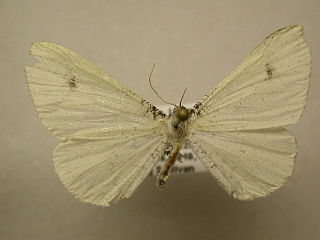
Macrosoma albida is moth-like butterfly described by William Schaus in 1901. It belongs to the family Hedylidae. Originally it belonged to the genus Hyphedyle.
Macrosoma albifascia is moth-like butterfly described by William Warren in 1904. It belongs to the family Hedylidae. Originally it belonged to the genus Phellinodes. A subspecies with the name M. albifascia albifascia was defined by Warren. Another subspecies M. albifascia expedita was proposed by Louis Beethoven Prout in 1932.
Macrosoma albimacula is moth-like butterfly described by William Warren in 1900. It belongs to the family Hedylidae. Originally it belonged to the genus Hyphedyle.
Macrosoma albipannosa is moth-like butterfly described by Louis Beethoven Prout in 1916. It belongs to the family Hedylidae. Originally it belonged to the genus Hedyle. Malcolm J. Scoble combined it with Macrosoma in 1986.
Macrosoma albistria is moth-like butterfly described by Louis Beethoven Prout in 1916. It belongs to the family Hedylidae. Originally it belonged to the genus Phellinodes. Malcolm J. Scoble combined it with Macrosoma in 1986.

Macrosoma bahiata is a moth-like butterfly species described by Rudolf Felder and Alois Friedrich Rogenhofer in 1875. It belongs to the family Hedylidae. Originally it belonged to the genus Phellinodes. Malcolm J. Scoble combined it with Macrosoma in 1986.

Macrosoma cascaria is moth-like butterfly described by William Schaus in 1901. It belongs to the family Hedylidae. Originally it belonged to the genus Hyphedyle. Malcolm J. Scoble combined it with Macrosoma in 1986.

Macrosoma conifera is moth-like butterfly described by Warren in 1897. It belongs to the family Hedylidae. Originally it belonged to the genus Phellinodes. Malcolm J. Scoble combined it with Macrosoma in 1986.
Macrosoma coscoja is moth-like butterfly described by Paul Dognin in 1900. It belongs to the family Hedylidae. Originally it belonged to the genus Phellinodes. Malcolm J. Scoble combined it with Macrosoma in 1986.
Macrosoma costilunata is moth-like butterfly described by Louis Beethoven Prout in 1916. It belongs to the family Hedylidae. Originally it belonged to the genus Phellinodes.
Macrosoma hedylaria is moth-like butterfly described by William Warren in 1894. It belongs to the family Hedylidae. Originally it belonged to the genus Phellinodes. Malcolm J. Scoble combined it with Macrosoma in 1986.
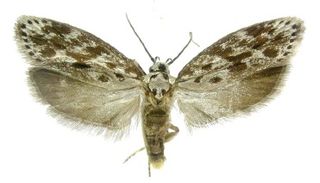
Ethmia dimauraorum is a moth in the family Depressariidae. It is found in Costa Rica, where it has been recorded at altitudes between 700 and 1,300 meters on the Pacific slope of the Cordillera de Guanacaste, at 750 meters (2,460 ft) in the Cordillera Central and at 1,000 meters (3,300 ft) at the Caribbean side of the Cordillera de Tilarán.
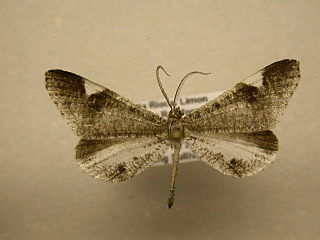
Macrosoma heliconiaria is moth-like butterfly described by Achille Guenée in 1857. It belongs to the family Hedylidae. Originally it belonged to the genus Hedyle. Malcolm J. Scoble combined it with Macrosoma in 1986. The species displays characteristics of both moths and butterflies and is believed to be the closest living ancestor to modern butterflies. Adaptions to avoid bat predation have given the species ultrasonic hearing and night vision through superposition optics.
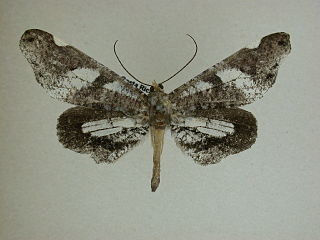
Macrosoma hyacinthina is moth-like butterfly described by William Warren in 1905. It belongs to the family Hedylidae. Originally it belonged to the genus Lasiopates. Malcolm J. Scoble combined it with Macrosoma in 1986.
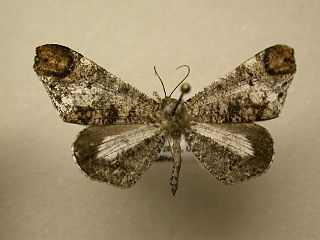
Macrosoma intermedia is moth-like butterfly described by Paul Dognin in 1911. It belongs to the Hedylidae family. Originally it belonged to the genus Phellinodes.
Macrosoma klagesi is moth-like butterfly described by Louis Beethoven Prout in 1916. It belongs to the family Hedylidae. Originally it belonged to the genus Phellinodes. Malcolm J. Scoble combined it with Macrosoma in 1986.
Macrosoma lamellifera is a moth-like butterfly in the family Hedylidae. It was described by Louis Beethoven Prout in 1916. It is hypothesized to be closely related to Macrosoma rubedinaria and Macrosoma ustrinaria, and though these groups fall within the same clade, they do not form a monophyletic group.







